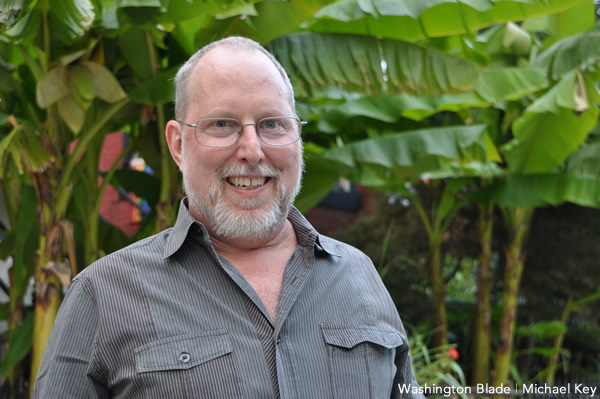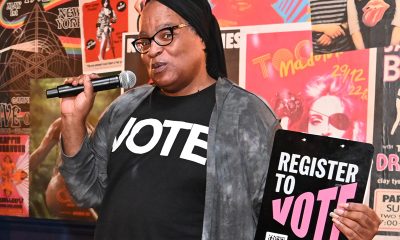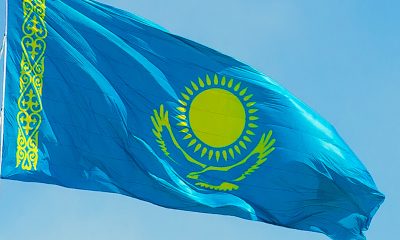Arts & Entertainment
Queery: Len Hirsch
The Rainbow History Project honoree and Federal GLOBE founder answers 20 gay questions
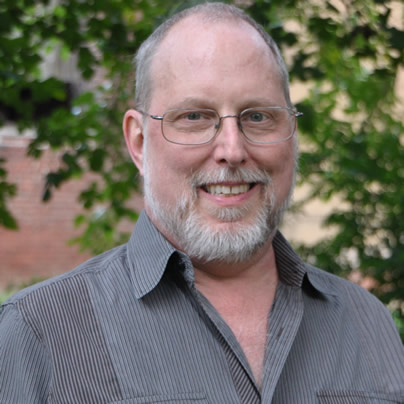
When Len Hirsch started at the Smithsonian in 1988 — he’s now a senior policy adviser working on environmental policy issues — he was fine being out but soon realized that although the agency was one of the more welcoming in the federal government, there were still many dealing with issues of discrimination and harassment and a lot who were not comfortable being out.
He’s being honored Thursday by the Rainbow History Project for his work founding Federal GLOBE: Gay, Lesbian, Bisexual, Transgender Employees of the Federal Government (fedglobe.org), a group that has worked since the late ‘80s to eliminate LGBT-based prejudice and discrimination in the federal government. Hirsch says it was one of several affinity groups that was formed about the same time or slightly before to address concerns of women and minorities.
One of their biggest victories was a 1997 executive order that removed sexual orientation as an issue of consideration in security clearances.
The Rainbow History Project’s Pioneers Reception is Thursday at the Thurgood Marshall Center (1816 12th St., N.W.) in Washington. Hirsch is one of 10 being honored this year (rainbowhistory.org).
He says it’s great to be recognized but notes there’s a lot of work left to do.
“I’m extremely honored and thrilled,” he says. “As a social scientist who studies social movements, there are always lots of good people doing lots of great things and only a few ever get any public acclaim. I was in a good place and a good time and did a lot of work but a lot of others did as well. My husband did so much too. He stuffed more envelopes than he’ll ever get credit for.”
Hirsch, a 57-year-old New York City native, spent time in California, Illinois and Florida before settling in Washington in 1985. He and husband Kristian Fauchald, a marine biologist, have been together nearly 30 years and live in D.C.
Hirsch enjoys politics, cooking, stained glass and dinner parties in his free time.
How long have you been out and who was the hardest person to tell?
Define out. On my 18th birthday, my girlfriend (later wife) and I went to Marie’s Crisis in New York. But when we split, the hardest to tell was myself. But I was quite convincing when I got around to it.
Who’s your LGBT hero?
Frank Kameny
What is Washington’s best nightspot, past or present?
Friends
Describe your dream wedding.
My husband smiling. We had it — small, intimate, good friends, some colleagues, some family. Openly gay federal judge presiding. All legal. My dream honeymoon will happen when we can get full benefits.
What non-LGBT issue are you most passionate about?
Environmentalism — loss of biodiversity and global change.
What historical outcome would you change?
The crucifixion.
What’s been the most memorable pop culture moment of your lifetime?
Does the LGBT ball at Clinton’s first inauguration count? If not, the 1987 LGBT March on Washington. Fourteen people crashed at our house (15 were there in the a.m.).
On what do you insist?
Equality, honesty, humor.
What was your last Facebook post or Tweet?
Congratulating my cousin for his participation in the U.S. Olympians visit to the White House (he was coxswain of the eight-man team).
If your life were a book, what would the title be?
“Without Boundaries”
If science discovered a way to change sexual orientation, what would you do?
Give it to Kinsey 0 heterosexuals.
What do you believe in beyond the physical world?
Nothing
What’s your advice for LGBT movement leaders?
Listen well (and have a cocktail).
What would you walk across hot coals for?
My husband. Peace.
What LGBT stereotype annoys you most?
Trendiness. Like all stereotypes, there are enough trendoids around to give it some credence, but I hope more of us are interested in quality. Not that size doesn’t matter, but that is for another time.
What’s your favorite LGBT movie?
“My Beautiful Laundrette”
What’s the most overrated social custom?
Reciprocity
What trophy or prize do you most covet?
Nobel Prize
What do you wish you’d known at 18?
That I didn’t need to act straight.
Why Washington?
Love, relationship and I am a policy wonk.
Bars & Parties
Mixtape Sapphics hosts holiday party on Dec. 13
‘Sugar & Spice’ night planned for Saturday

Mixtape Sapphics will host “Sapphic Sugar & Spice: A Naughty-Nice Mixtape Holiday Party” on Saturday, Dec. 13 at 4 p.m. at Amsterdam Lounge.
This is a festive, grown holiday party for queer women and sapphics 35 and older at Revolt’s Christmas pop-up. There will be music, joy, and an optional White Elephant.
This is Mixtape Sapphics’ first-ever holiday party — a cozy, flirty, intentionally grounded night created just for queer women and sapphics 35+ who want real connection, festive joy, and a warm place to land at the end of the year.
Tickets start at $13.26 and can be purchased on Eventbrite.
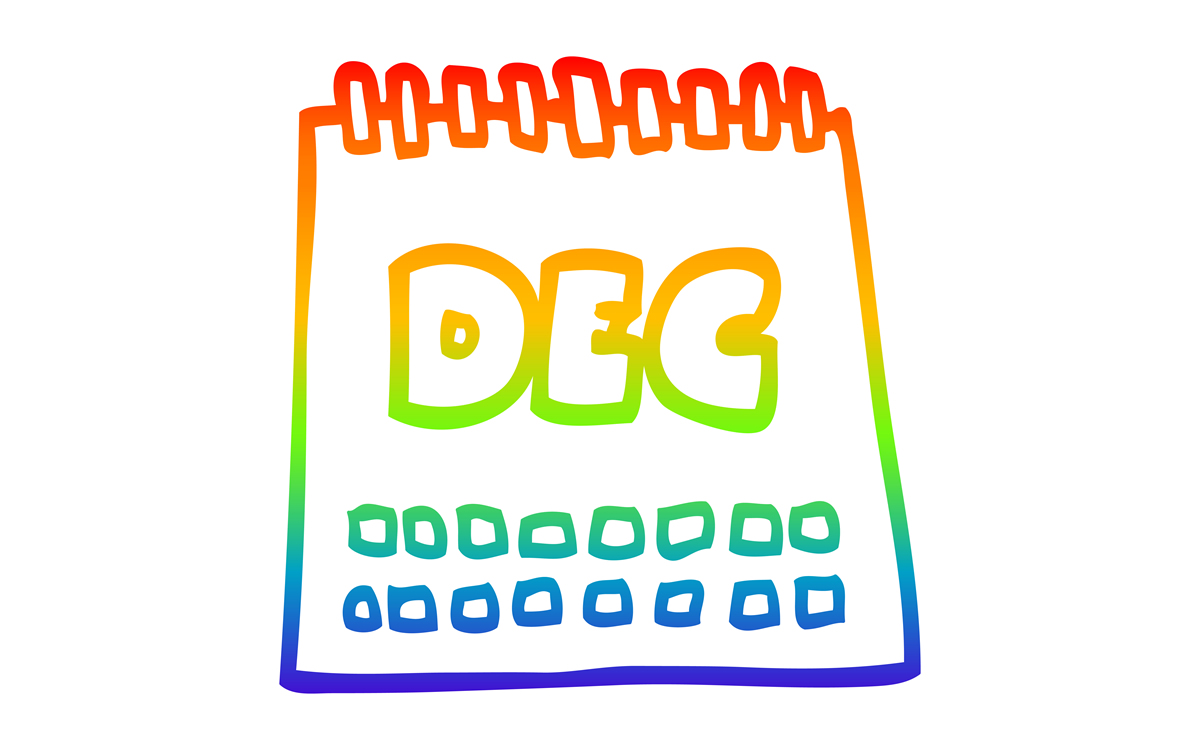
Friday, December 12
“Center Aging Friday Tea Time” will be at 12 p.m. in person at the DC Center for the LGBT Community’s new location at 1827 Wiltberger St., N.W. To RSVP, visit the DC Center’s website or email [email protected].
Go Gay DC will host “LGBTQ+ Community Happy Hour” at 7 p.m. at Freddie’s Beach Bar and Restaurant. This event is ideal for making new friends, professional networking, idea-sharing, and community building. This event is free and more details are available on Eventbrite.
Women in Their Twenties and Thirties will be at 8 p.m. on Zoom. This is a social discussion group for queer women in the Washington, D.C. area. For more details, go to Facebook.
Saturday, December 13
Go Gay DC will host “LGBTQ+ Community Brunch” at 12 p.m. at Freddie’s Beach Bar & Restaurant. This fun weekly event brings the DMV area LGBTQ+ community, including allies, together for delicious food and conversation. Attendance is free and more details are available on Eventbrite.
The DC Center for the LGBT Community will host “Sunday Supper on Saturday” at 2 p.m. D.C.’s queer community will gather for good food, laughter, and community. For more information, email [email protected].
Sunday, December 14
SADBrunch will host “HokiSlay Drag Brunch” at 12 p.m. at Throw Social. This festive affair brings fierce performances, over-the-top holiday looks, and more sparkle than a tinsel explosion. Expect powerhouse lip-syncs, laughter, and cheer hotter than your spiked cocoa. Cake Pop will host the event. Tickets cost $28.52 and are available on Eventbrite.
Monday, December 15
“Center Aging: Monday Coffee Klatch” will be at 10 a.m. on Zoom. This is a social hour for older LGBTQ+ adults. Guests are encouraged to bring a beverage of choice. For more information, contact Adam ([email protected]).
Genderqueer DC will be at 7 p.m. on Zoom. This is a support group for people who identify outside of the gender binary, whether you’re bigender, agender, genderfluid, or just know that you’re not 100% cis. For more details, visit genderqueerdc.org or Facebook.
Tuesday, December 16
Center Bi+ Roundtable will be at 7 p.m. on Zoom. This is an opportunity for people to gather and discuss issues related to bisexuality or as Bi individuals in a private setting. Visit Facebook or Meetup for more information.
The DC Center for the LGBT Community will host “Self-Defense Class with Avi Rome” at 12:30 p.m. Rome is a proud member of the LGBTQ community and a full-time martial arts instructor with 25 years of teaching experience. He holds a Fifth Degree Black Belt in Jhoon Rhee Tae Kwon Do and is the director of the studio’s Adaptive Tae Kwon Do program for students with special needs. He has also run numerous self-defense workshops for various groups and situations. For more details, visit the center’s website.
Wednesday, December 17
Job Club will be at 6 p.m. on Zoom upon request. This is a weekly job support program to help job entrants and seekers, including the long-term unemployed, improve self-confidence, motivation, resilience and productivity for effective job searches and networking — allowing participants to move away from being merely “applicants” toward being “candidates.” For more information, email [email protected] or visit thedccenter.org/careers.
Asexual and Aromantic Group will be at 7 p.m. on Zoom. This is a space where people who are questioning this aspect of their identity or those who identify as asexual and/or aromantic can come together, share stories and experiences, and discuss various topics. For more details, email [email protected].
Thursday, December 18
The DC Center’s Fresh Produce Program will be held all day at the DC Center for the LGBT Community. People will be informed on Wednesday at 5 p.m. if they are picked to receive a produce box. No proof of residency or income is required. For more information, email [email protected] or call 202-682-2245.
Virtual Yoga Class will be at 7 p.m. on Zoom. This free weekly class is a combination of yoga, breath work and meditation that allows LGBTQ+ community members to continue their healing journey with somatic and mindfulness practices. For more details, visit the DC Center’s website.
Egypt
Iran, Egypt object to playing in Seattle World Cup ‘Pride Match’
Game to take place on June 26

Iran and Egypt have objected to playing in a “Pride Match” that will take place in Seattle during the 2026 World Cup.
The Egyptian Football Association on Tuesday said it told FIFA Secretary General Mattias Grafström in a letter that “it categorically rejects holding any activities related to supporting (homosexuality) during the match between the Egyptian national team and Iran, scheduled to be held in Seattle, USA, on June 26, 2026, in the third round of the group stage of the 2026 World Cup.” Football Federation Islamic Republic of Iran President Mehdi Taj told ISNA, a semi-official Iranian news agency that both his country and Egypt “protested this issue.”
The 2026 World Cup will take place in the U.S., Canada, and Mexico. The draw took place at the Kennedy Center on Dec. 5.
Iran is among the handful of countries in which consensual same-sex sexual relations remain punishable by death.
The State Department’s 2023 human rights report notes that while Egyptian law “did not explicitly criminalize consensual same-sex sexual activity, authorities regularly arrested and prosecuted LGBTQI+ persons on charges including ‘debauchery,’ prostitution, and ‘violating family values.’” Egyptian authorities “also reportedly prosecuted LGBTQI+ individuals for ‘misuse of social media.’”
“This resulted in de facto criminalization of same-sex conduct and identity,” notes the report.
The 2024 human rights report the State Department released earlier this year did not include LGBTQ-specific references.
Soccer has ‘unique power to unite people across borders, cultures, and beliefs’
The June 26 match between Iran and Egypt coincides with Seattle Pride. The Washington Post reported the Seattle FIFA World Cup 2026 Local Organizing Committee decided to hold the “Pride Match” before last week’s draw.
“As the Local Organizing Committee, SeattleFWC26’s role is to prepare our city to host the matches and manage the city experience outside of Seattle Stadium,” said SeattleFWC26 Vice President of Communications Hana Tadesse in a statement the committee sent to the Washington Blade on Wednesday. “SeattleFWC26 is moving forward as planned with our community programming outside the stadium during Pride weekend and throughout the tournament, partnering with LGBTQ+ leaders, artists, and business owners to elevate existing Pride celebrations across Washington.”
“Football has a unique power to unite people across borders, cultures, and beliefs,” added Tadeese. “The Pacific Northwest is home to one of the nation’s largest Iranian-American communities, a thriving Egyptian diaspora, and rich communities representing all nations we’re hosting in Seattle. We’re committed to ensuring all residents and visitors experience the warmth, respect, and dignity that defines our region.”
The 2034 World Cup will take place in Saudi Arabia.
Consensual same-sex sexual relations remain punishable by death in the country. The 2022 World Cup took place in neighboring Qatar, despite concerns over the country’s anti-LGBTQ rights record.

